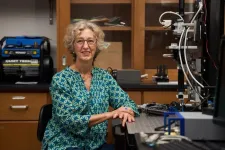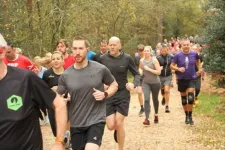(Press-News.org) A Cleveland Clinic-led research collaboration between Timothy Chan, MD, PhD, Chair of Cleveland Clinic’s Global Center for Immunotherapy, and Bristol Myers Squibb has published the most comprehensive overview to date of how the immune system reshapes tumor architecture in response to immune checkpoint therapy.
The eight-year study, published in Nature Medicine, outlines how cancer immunotherapy induces tumor recognition through neoantigens to reshape the tumor ecosystem. Neoantigens are small peptides produced when cancer cells mutate and are a primary marker for the immune system to recognize cancer cells as different from self.
“This study is unique in that we sampled tumors prior to therapy and then early after immunotherapy was initiated,” explains Dr. Chan, who is also chair of Cleveland Clinic’s Center for Immunotherapy & Precision Immuno-Oncology, program leader of Case Comprehensive Cancer Center's Immune Oncology Program and the Sheikha Fatima bint Mubarak Endowed Chair in Immunotherapy. “Our goal was to understand how patients’ tumors are recognized and altered by their immune system in response to immunotherapy.”
Our immune cells and cancer cells constantly interact and influence one another over the course of cancer. Immunotherapy treatments need to operate within that framework by boosting our immune cells to eliminate cancer. Scientists like Dr. Chan have begun to untangle the complex relationships between treatment, immunity and cancer in the past 15 years – but human data is in short supply.
The CheckMate-153 trial was overseen by pharmaceutical company Bristol Myers Squibb and Dr. Chan’s team was a central site for the trial’s analysis. Within the primary trial, investigators included a biomarker sub-study to identify how neoantigens drive response to nivolumab by sampling patients’ tumors pre-therapy and 3 weeks post-therapy. From these tumor samples, sequencing was used to identify mutations that create neoantigens.
Neoantigens are thought to be the primary way that the immune system recognizes tumors, but neoantigen prediction tools lack accuracy due to lack existing data in this space. To overcome this issue the team developed the largest neoantigen screen to date, where they validated their predictions and monitored the dynamic response to neoantigens with longitudinal blood draws.
Within three weeks of treatment, people who went on to respond well to nivolumab had a sharp decline in clonal neoantigens. Meanwhile, individuals whose cancer did not go into remission still mounted an immunologic response but to smaller sub-clonal populations. This is important because many believed that non-responders were unable to activate and recognize tumor, but here they show it may be that the immune system is mounting a response to neoantigens but that this is insufficient to destroy all tumor clones.
Current neoantigen prediction tools rely heavily on HLA-binding neoantigens, but they are missing the T cell recognition aspect of immunogenicity, says Cleveland Clinic’s co-first author Tyler Alban, PhD, Project Staff in the Chan Lab. Dr. Alban, data scientist Prerana Parthasarathy, and others on the team developed a machine-learning program that uses the new screening data to better predict immunogenic neoantigens. In the process, the program identified novel features harbored by these cancer-derived neoantigens.
“We observed a whole ecosystem of immune cells at work, with each T cell recognizing a different neoantigen altering the clonal makeup of the tumor,” Dr. Alban says. “Our data let us generate new insights into neoantigens and resistance to immunotherapy.”
By cataloguing changes to neoantigens during treatment, Dr. Alban’s analyses challenged the prevailing theory in immunotherapy: that a tumor only needs one lucky mutation to develop features our immune systems recognize as a threat. The results show that many different T cells recognizing many different cancer-causing features are needed to respond well to treatment.
Roadmaps generated by these types of observational studies will be critical in navigating future immuno-oncology research, Dr. Chan says.
“Learning why our immune systems respond to some cancerous mutations but not others are like the holy grail for immunotherapy researchers,” he explains. “Our findings are one of the closest things we have to figuring these things out.”
The group is also using their dataset in collaboration with IBM in the Cleveland Clinic - IBM Discovery Accelerator to more advanced AI models that predict new molecules for cancer treatments and cancer vaccine development.
END
Cleveland Clinic researchers build first large-scale atlas of how immune cells react to mutations during cancer immunotherapy
Examining mutations and neoantigens in patients over their treatment with nivolumab opens the door to refining immunotherapies
2024-10-01
ELSE PRESS RELEASES FROM THIS DATE:
Pioneering quantum computer research continues in Baden-Württemberg
2024-10-01
Utilizing the potential of quantum computers and achieving a real advantage for practical applications — this goal is being pursued worldwide. In Baden-Württemberg, the Competence Center Quantum Computing Baden-Württemberg (KQCBW) has dedicated itself to this goal over the past four years. Great progress has been made in various areas of quantum computing in successful joint projects. The success of the KQCBW is now to be continued and the unique quantum computing ecosystem in the state further expanded.
The KQCBW will be continued in a ten-month transfer project ...
Discovery of orbital angular momentum monopoles enables orbital electronics with chiral materials
2024-10-01
In traditional electronics, information is transferred using the charge of electrons. However, future technologies may rely on a different property of electrons—their intrinsic angular momentum. Historically, the focus has been on electron spin, a form of build-in angular momentum that creates a magnetic moment, as the leading candidate for next-generation devices. Now, researchers are exploring the potential of orbitronics, a field that utilizes the angular momentum of electrons generated as they orbit the atomic nucleus. Orbitronics holds great promise ...
New mouse models offer valuable window into COVID-19 infection
2024-10-01
LA JOLLA, CA—Scientists at La Jolla Institute for Immunology (LJI) have developed six lines of humanized mice that can serve as valuable models for studying human cases of COVID-19.
According to their new study in eBioMedicine, these mouse models are important for COVID-19 research because their cells were engineered to include two important human molecules that are involved in SARS-CoV-2 infection of human cells—and these humanized mice were generated on two different immunologic backgrounds. ...
Antibodies in breast milk provide protection against common GI virus
2024-10-01
A study led by researchers at the University of Rochester Medical Center found that breast milk provides protection against rotavirus, a common gastrointestinal disease that causes diarrhea, vomiting and fever in infants. Babies whose mothers had high levels of specific antibodies in their breast milk were able to fend off the infection for a longer period than infants whose mothers had lower levels. The findings are expected to drive future research to improve infant health through optimized breastfeeding practices.
Published in the Journal of Clinical Investigation and funded by the Bill and Melinda Gates Foundation, the study also ...
University of Cincinnati professor named MacArthur fellow
2024-10-01
When the phone rang on a September afternoon, University of Cincinnati's Shailaja Paik, PhD, tired from a full day of meetings and teaching, did not expect to hear news that would leave her “ears numb.”
“I had been named a (MacArthur) fellow, and I wasn’t sure I was hearing correctly, but I tried to keep my cool,” she remembers, chuckling. “I thought, ‘Is this right? I’m going to ask her to repeat herself.’
“I was ecstatic.”
The MacArthur Fellows Program, also ...
Research provides new insights into role of mechanical forces in gene expression
2024-10-01
The genome inside each of our cells is modelled by tension and torsion — due in part to the activity of proteins that compact, loop, wrap and untwist DNA — but scientists know little about how those forces affect the transcription of genes.
“There are a lot of mechanical forces at play all the time that we never consider, we have very little knowledge of, and they’re not talked about in textbooks,” said Laura Finzi, the Dr. Waenard L. Miller, Jr. ’69 and Sheila M. Miller Endowed Chair in Medical Biophysics at Clemson University.
Transcription is the process by which a cell makes an RNA copy of a segment of DNA. One ...
HSE scientists have developed a new model of electric double layer
2024-10-01
This new model accounts for a wide range of ion-electrode interactions and predicts a device's ability to store electric charge. The model's theoretical predictions align with the experimental results. Data on the behaviour of the electric double layer (EDL) can aid in the development of more efficient supercapacitors for portable electronics and electric vehicles. The study has been published in ChemPhysChem.
Many devices store energy for future use, with batteries being among the most well-known examples. They can consistently release energy, maintaining steady power output regardless of existing conditions or load, until fully ...
UK ParkRun participants report improved life satisfaction six months later
2024-10-01
UK ParkRun participants report improved life satisfaction six months later, with most benefit for the least active people, and an estimated value between £16.70 and £98.50 for every £1 of running costs.
####
Article URL: https://journals.plos.org/globalpublichealth/article?id=10.1371/journal.pgph.0003580
Article Title: The impact of parkrun on life satisfaction and its cost-effectiveness: A six-month study of parkrunners in the United Kingdom
Author Countries: United Kingdom
Funding: This study was funded by Sheffield Hallam University (SJH and AB) and by The University of Sheffield (HQ). The funders had no role in study design, data collection and analysis, ...
‘Who’s a good boy?’ Humans use dog-specific voices for better canine comprehension
2024-10-01
The voice people use to address their dogs isn’t just because of their big puppy eyes. Humans slow their own speech when talking to their dogs, and this slower tempo matches their pets’ receptive abilities, allowing the dogs to better understand their commands, according to a study published October 1st in the open-access journal PLOS Biology by Eloïse Déaux of the University of Geneva in Switzerland and colleagues.
Dogs respond to human speech, even though they themselves cannot produce human sounds. To better understand how people ...
A third of Swedish cheerleaders tell of psychological abuse
2024-10-01
Of current and former cheerleading athletes in Sweden, 29% reported being subjected to psychological abuse in the sport, according to a new study from Linköping University, Sweden. The study shows that dissatisfaction with leadership, injuries, high expectations and bad atmosphere in the team are major reasons why athletes give up the sport.
“It’s similar to what we see in other sports: that it’s primarily psychological abuse that stands out,” says Carolina Lundqvist, docent in psychology and sports science and licensed psychotherapist at the Department of Behavioural Sciences at Linköping ...
LAST 30 PRESS RELEASES:
Review article | Towards a Global Ground-Based Earth Observatory (GGBEO): Leveraging existing systems and networks
Penn and UMich create world’s smallest programmable, autonomous robots
Cleveland researchers launch first major study to address ‘hidden performance killer’ in athletes
To connect across politics, try saying what you oppose
Modulating key interaction prevents virus from entering cells
Project explores barriers to NHS career progression facing international medical graduates
Jeonbuk National University researchers explore the impact of different seasonings on the flavor perception of Doenjang soup
Two Keck Medicine of USC Hospitals named Leapfrog Top Teaching Hospitals
World-first discovery uncovers how glioblastoma tumours dodge chemotherapy, potentially opening the door to new treatments
A fatal mix-up: How certain gut bacteria drive multiple sclerosis
New AI tool identifies not just genetic mutations, but the diseases they may cause
Deep-learning model predicts how fruit flies form, cell by cell
Combination pills for high blood pressure may simplify treatment, improve long-term health
Immune system keeps mucosal fungi in check
Neurons within the brain use simple rules to localize genetic messages
Electrodes created using light
Second-hand gift-giving is a well-deliberated decision
How human interaction drove evolution to make bears less aggressive
National Poll: Few parents offer teens guidance on healthy eating during holiday season
Cannabis derivatives could provide new ovarian cancer treatments
Raising strong yeast as a petroleum substitute
Clues to the origin of hot Jupiters hidden in their orbits
Canada’s reduced pledge to Global Fund will impact domestic health
1 in 4 children with major traumatic injuries not cared for in pediatric trauma centres
Duke and Duke-NUS’ joint cross-population research to uncover "East-West" differences in disease and care
Scientists to ‘spy’ on cancer- immune cell interactions using quantum technology breakthrough
Tech savvy users have most digital concerns
Making lighter work of calculating fluid and heat flow
Normalizing blood sugar can halve heart attack risk
Lowering blood sugar cuts heart attack risk in people with prediabetes
[Press-News.org] Cleveland Clinic researchers build first large-scale atlas of how immune cells react to mutations during cancer immunotherapyExamining mutations and neoantigens in patients over their treatment with nivolumab opens the door to refining immunotherapies






